Diabetic Foot Ulcer: Pathophysiology, Nursing Interventions, and Management Strategies
VerifiedAdded on 2023/01/18
|12
|2965
|24
AI Summary
This article discusses the pathophysiology of diabetic foot ulcers and explores nursing interventions and management strategies for effective treatment. It highlights the importance of addressing risk factors and promoting healing. The case study of Mrs. Gina Bacci, a patient with high glucose levels and critical foot ulcer complications, is used as an example. The article also emphasizes the role of physical activities, proper wound dressing, and patient education in the management of diabetic foot ulcers.
Contribute Materials
Your contribution can guide someone’s learning journey. Share your
documents today.
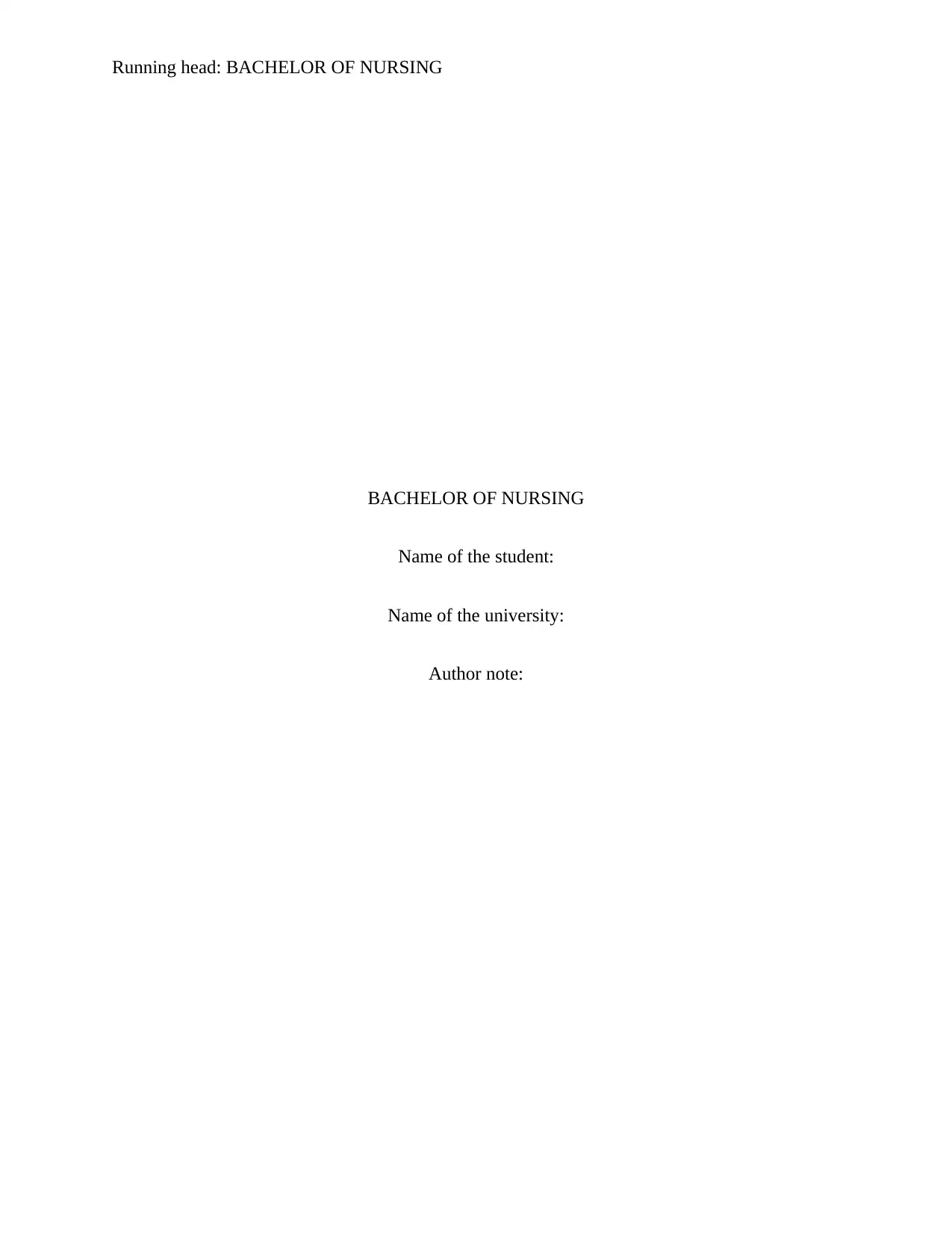
Running head: BACHELOR OF NURSING
BACHELOR OF NURSING
Name of the student:
Name of the university:
Author note:
BACHELOR OF NURSING
Name of the student:
Name of the university:
Author note:
Secure Best Marks with AI Grader
Need help grading? Try our AI Grader for instant feedback on your assignments.
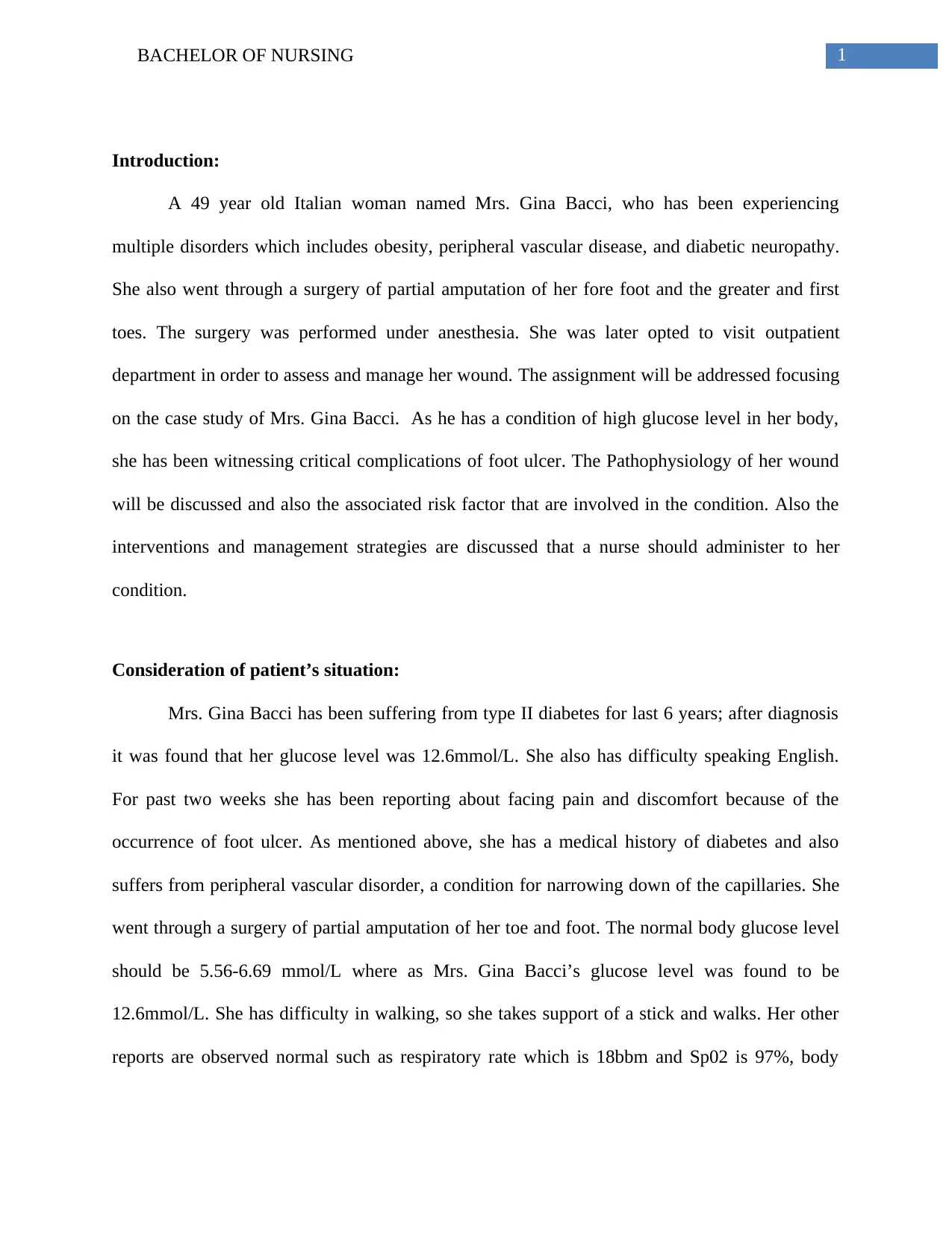
1BACHELOR OF NURSING
Introduction:
A 49 year old Italian woman named Mrs. Gina Bacci, who has been experiencing
multiple disorders which includes obesity, peripheral vascular disease, and diabetic neuropathy.
She also went through a surgery of partial amputation of her fore foot and the greater and first
toes. The surgery was performed under anesthesia. She was later opted to visit outpatient
department in order to assess and manage her wound. The assignment will be addressed focusing
on the case study of Mrs. Gina Bacci. As he has a condition of high glucose level in her body,
she has been witnessing critical complications of foot ulcer. The Pathophysiology of her wound
will be discussed and also the associated risk factor that are involved in the condition. Also the
interventions and management strategies are discussed that a nurse should administer to her
condition.
Consideration of patient’s situation:
Mrs. Gina Bacci has been suffering from type II diabetes for last 6 years; after diagnosis
it was found that her glucose level was 12.6mmol/L. She also has difficulty speaking English.
For past two weeks she has been reporting about facing pain and discomfort because of the
occurrence of foot ulcer. As mentioned above, she has a medical history of diabetes and also
suffers from peripheral vascular disorder, a condition for narrowing down of the capillaries. She
went through a surgery of partial amputation of her toe and foot. The normal body glucose level
should be 5.56-6.69 mmol/L where as Mrs. Gina Bacci’s glucose level was found to be
12.6mmol/L. She has difficulty in walking, so she takes support of a stick and walks. Her other
reports are observed normal such as respiratory rate which is 18bbm and Sp02 is 97%, body
Introduction:
A 49 year old Italian woman named Mrs. Gina Bacci, who has been experiencing
multiple disorders which includes obesity, peripheral vascular disease, and diabetic neuropathy.
She also went through a surgery of partial amputation of her fore foot and the greater and first
toes. The surgery was performed under anesthesia. She was later opted to visit outpatient
department in order to assess and manage her wound. The assignment will be addressed focusing
on the case study of Mrs. Gina Bacci. As he has a condition of high glucose level in her body,
she has been witnessing critical complications of foot ulcer. The Pathophysiology of her wound
will be discussed and also the associated risk factor that are involved in the condition. Also the
interventions and management strategies are discussed that a nurse should administer to her
condition.
Consideration of patient’s situation:
Mrs. Gina Bacci has been suffering from type II diabetes for last 6 years; after diagnosis
it was found that her glucose level was 12.6mmol/L. She also has difficulty speaking English.
For past two weeks she has been reporting about facing pain and discomfort because of the
occurrence of foot ulcer. As mentioned above, she has a medical history of diabetes and also
suffers from peripheral vascular disorder, a condition for narrowing down of the capillaries. She
went through a surgery of partial amputation of her toe and foot. The normal body glucose level
should be 5.56-6.69 mmol/L where as Mrs. Gina Bacci’s glucose level was found to be
12.6mmol/L. She has difficulty in walking, so she takes support of a stick and walks. Her other
reports are observed normal such as respiratory rate which is 18bbm and Sp02 is 97%, body
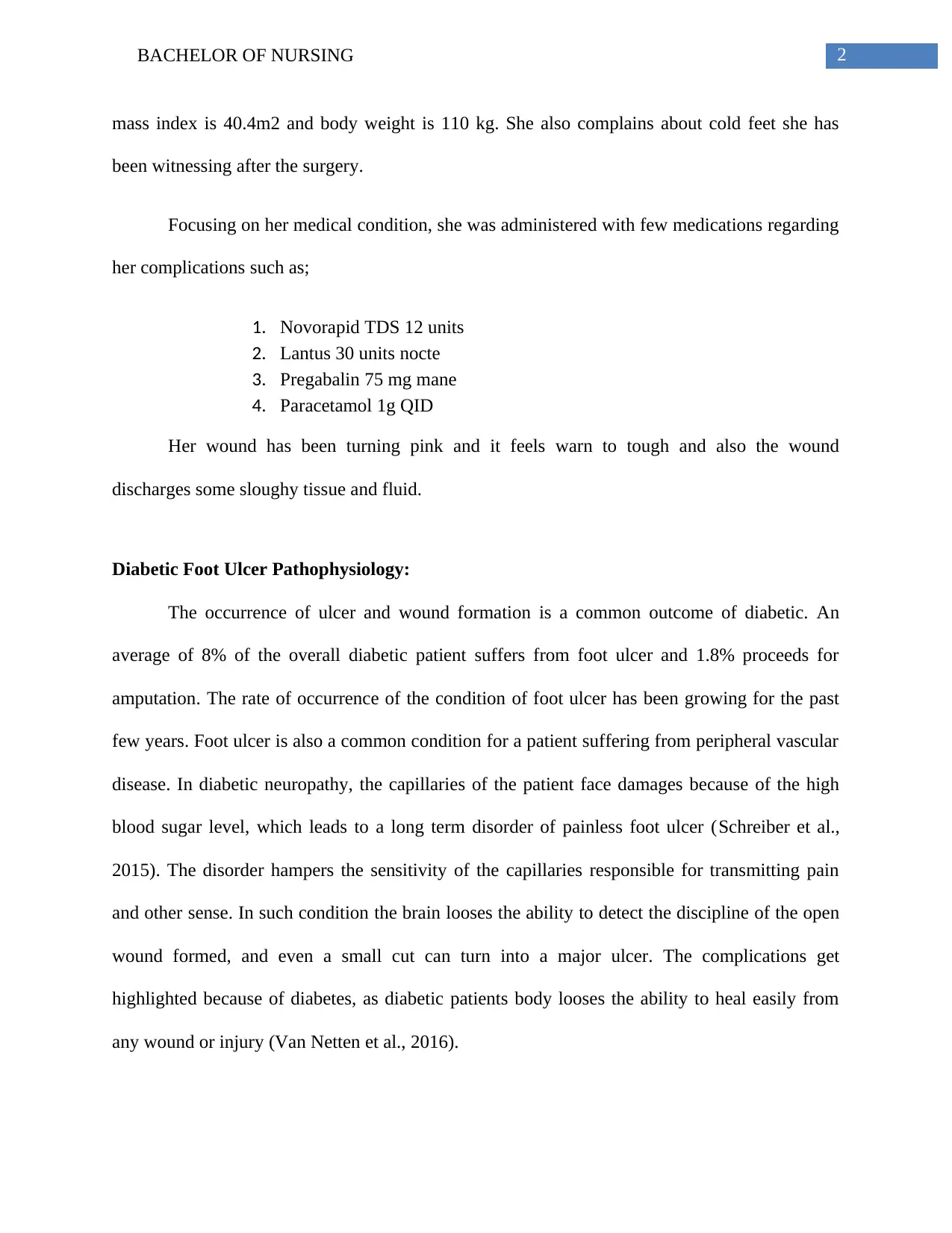
2BACHELOR OF NURSING
mass index is 40.4m2 and body weight is 110 kg. She also complains about cold feet she has
been witnessing after the surgery.
Focusing on her medical condition, she was administered with few medications regarding
her complications such as;
1. Novorapid TDS 12 units
2. Lantus 30 units nocte
3. Pregabalin 75 mg mane
4. Paracetamol 1g QID
Her wound has been turning pink and it feels warn to tough and also the wound
discharges some sloughy tissue and fluid.
Diabetic Foot Ulcer Pathophysiology:
The occurrence of ulcer and wound formation is a common outcome of diabetic. An
average of 8% of the overall diabetic patient suffers from foot ulcer and 1.8% proceeds for
amputation. The rate of occurrence of the condition of foot ulcer has been growing for the past
few years. Foot ulcer is also a common condition for a patient suffering from peripheral vascular
disease. In diabetic neuropathy, the capillaries of the patient face damages because of the high
blood sugar level, which leads to a long term disorder of painless foot ulcer (Schreiber et al.,
2015). The disorder hampers the sensitivity of the capillaries responsible for transmitting pain
and other sense. In such condition the brain looses the ability to detect the discipline of the open
wound formed, and even a small cut can turn into a major ulcer. The complications get
highlighted because of diabetes, as diabetic patients body looses the ability to heal easily from
any wound or injury (Van Netten et al., 2016).
mass index is 40.4m2 and body weight is 110 kg. She also complains about cold feet she has
been witnessing after the surgery.
Focusing on her medical condition, she was administered with few medications regarding
her complications such as;
1. Novorapid TDS 12 units
2. Lantus 30 units nocte
3. Pregabalin 75 mg mane
4. Paracetamol 1g QID
Her wound has been turning pink and it feels warn to tough and also the wound
discharges some sloughy tissue and fluid.
Diabetic Foot Ulcer Pathophysiology:
The occurrence of ulcer and wound formation is a common outcome of diabetic. An
average of 8% of the overall diabetic patient suffers from foot ulcer and 1.8% proceeds for
amputation. The rate of occurrence of the condition of foot ulcer has been growing for the past
few years. Foot ulcer is also a common condition for a patient suffering from peripheral vascular
disease. In diabetic neuropathy, the capillaries of the patient face damages because of the high
blood sugar level, which leads to a long term disorder of painless foot ulcer (Schreiber et al.,
2015). The disorder hampers the sensitivity of the capillaries responsible for transmitting pain
and other sense. In such condition the brain looses the ability to detect the discipline of the open
wound formed, and even a small cut can turn into a major ulcer. The complications get
highlighted because of diabetes, as diabetic patients body looses the ability to heal easily from
any wound or injury (Van Netten et al., 2016).
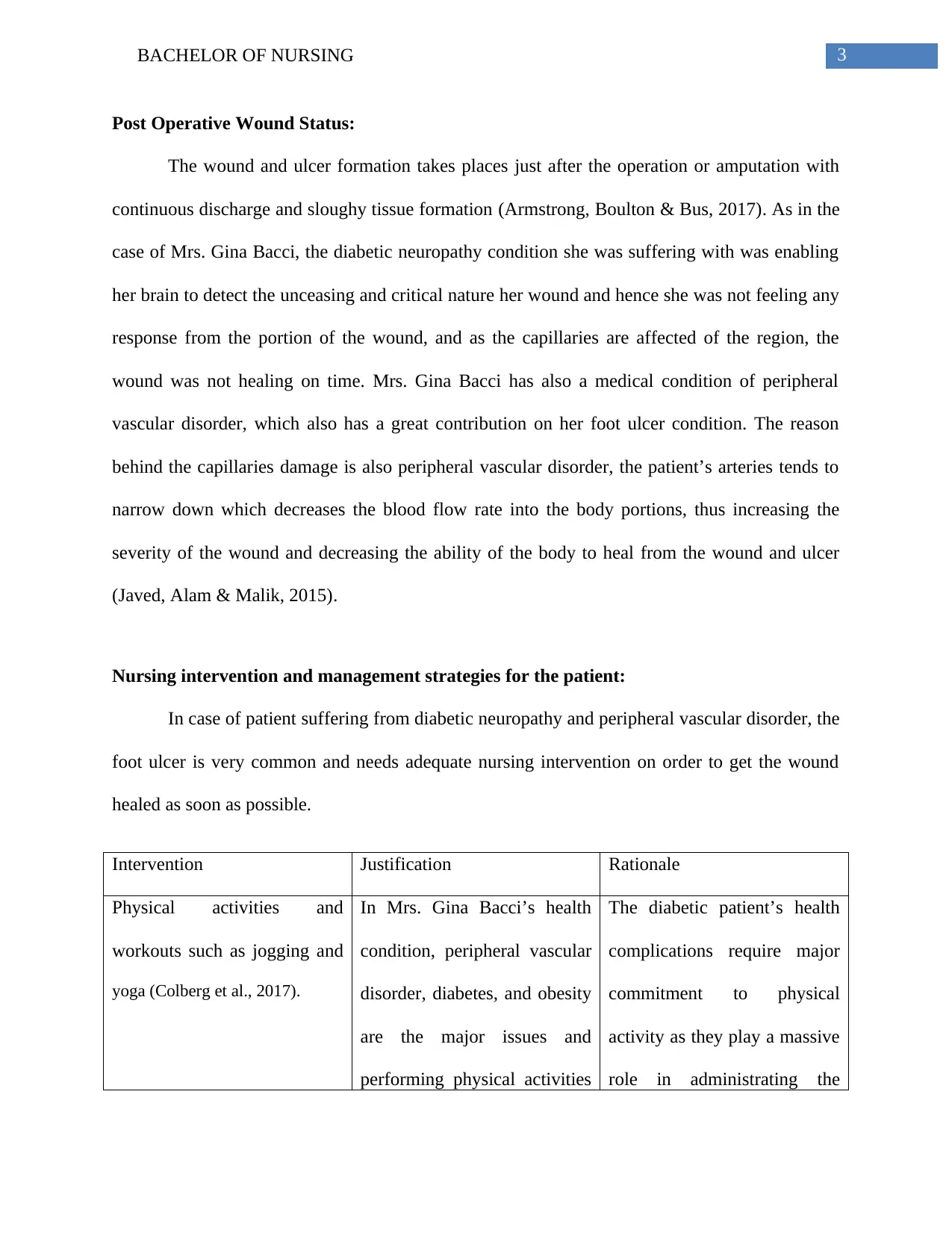
3BACHELOR OF NURSING
Post Operative Wound Status:
The wound and ulcer formation takes places just after the operation or amputation with
continuous discharge and sloughy tissue formation (Armstrong, Boulton & Bus, 2017). As in the
case of Mrs. Gina Bacci, the diabetic neuropathy condition she was suffering with was enabling
her brain to detect the unceasing and critical nature her wound and hence she was not feeling any
response from the portion of the wound, and as the capillaries are affected of the region, the
wound was not healing on time. Mrs. Gina Bacci has also a medical condition of peripheral
vascular disorder, which also has a great contribution on her foot ulcer condition. The reason
behind the capillaries damage is also peripheral vascular disorder, the patient’s arteries tends to
narrow down which decreases the blood flow rate into the body portions, thus increasing the
severity of the wound and decreasing the ability of the body to heal from the wound and ulcer
(Javed, Alam & Malik, 2015).
Nursing intervention and management strategies for the patient:
In case of patient suffering from diabetic neuropathy and peripheral vascular disorder, the
foot ulcer is very common and needs adequate nursing intervention on order to get the wound
healed as soon as possible.
Intervention Justification Rationale
Physical activities and
workouts such as jogging and
yoga (Colberg et al., 2017).
In Mrs. Gina Bacci’s health
condition, peripheral vascular
disorder, diabetes, and obesity
are the major issues and
performing physical activities
The diabetic patient’s health
complications require major
commitment to physical
activity as they play a massive
role in administrating the
Post Operative Wound Status:
The wound and ulcer formation takes places just after the operation or amputation with
continuous discharge and sloughy tissue formation (Armstrong, Boulton & Bus, 2017). As in the
case of Mrs. Gina Bacci, the diabetic neuropathy condition she was suffering with was enabling
her brain to detect the unceasing and critical nature her wound and hence she was not feeling any
response from the portion of the wound, and as the capillaries are affected of the region, the
wound was not healing on time. Mrs. Gina Bacci has also a medical condition of peripheral
vascular disorder, which also has a great contribution on her foot ulcer condition. The reason
behind the capillaries damage is also peripheral vascular disorder, the patient’s arteries tends to
narrow down which decreases the blood flow rate into the body portions, thus increasing the
severity of the wound and decreasing the ability of the body to heal from the wound and ulcer
(Javed, Alam & Malik, 2015).
Nursing intervention and management strategies for the patient:
In case of patient suffering from diabetic neuropathy and peripheral vascular disorder, the
foot ulcer is very common and needs adequate nursing intervention on order to get the wound
healed as soon as possible.
Intervention Justification Rationale
Physical activities and
workouts such as jogging and
yoga (Colberg et al., 2017).
In Mrs. Gina Bacci’s health
condition, peripheral vascular
disorder, diabetes, and obesity
are the major issues and
performing physical activities
The diabetic patient’s health
complications require major
commitment to physical
activity as they play a massive
role in administrating the
Secure Best Marks with AI Grader
Need help grading? Try our AI Grader for instant feedback on your assignments.
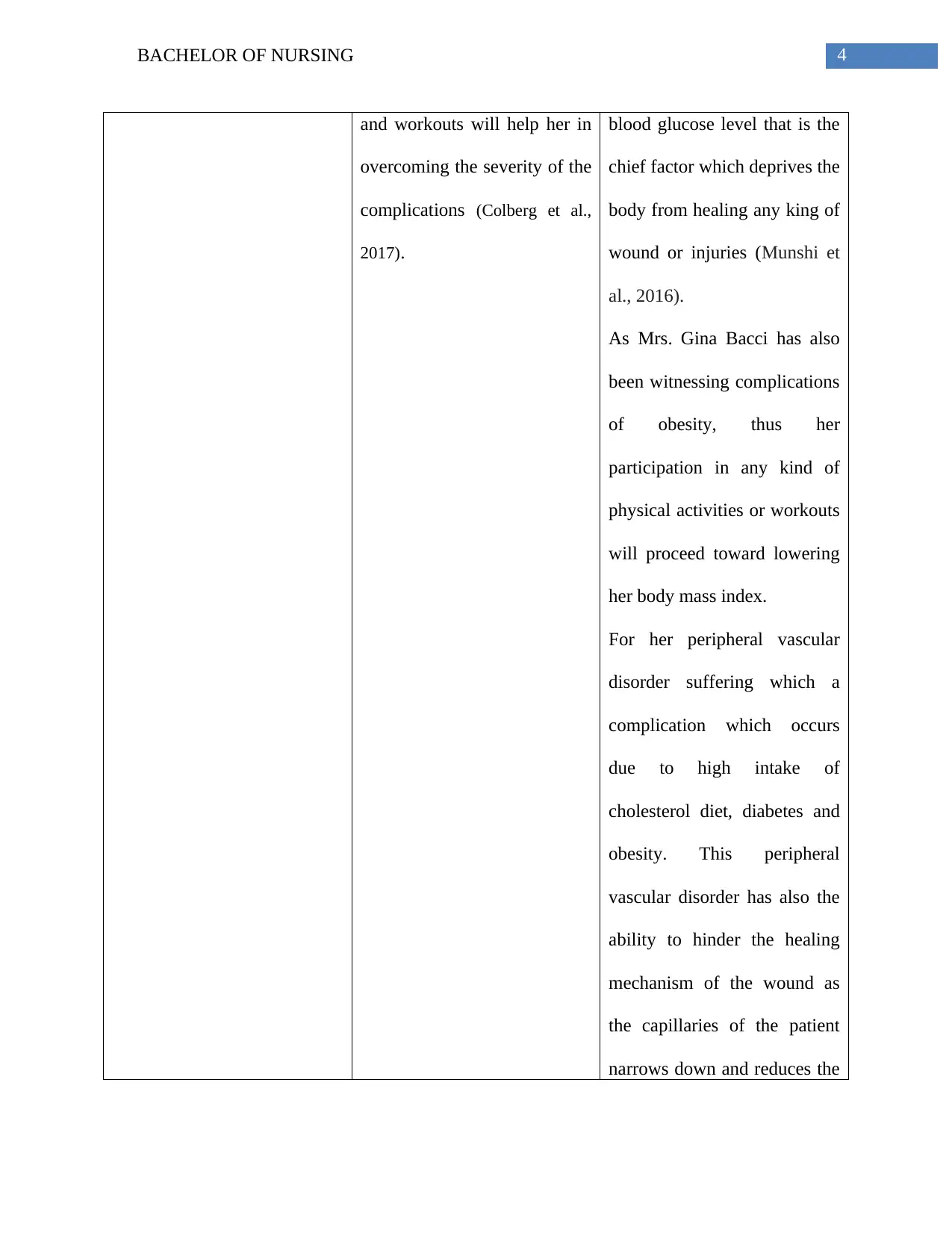
4BACHELOR OF NURSING
and workouts will help her in
overcoming the severity of the
complications (Colberg et al.,
2017).
blood glucose level that is the
chief factor which deprives the
body from healing any king of
wound or injuries (Munshi et
al., 2016).
As Mrs. Gina Bacci has also
been witnessing complications
of obesity, thus her
participation in any kind of
physical activities or workouts
will proceed toward lowering
her body mass index.
For her peripheral vascular
disorder suffering which a
complication which occurs
due to high intake of
cholesterol diet, diabetes and
obesity. This peripheral
vascular disorder has also the
ability to hinder the healing
mechanism of the wound as
the capillaries of the patient
narrows down and reduces the
and workouts will help her in
overcoming the severity of the
complications (Colberg et al.,
2017).
blood glucose level that is the
chief factor which deprives the
body from healing any king of
wound or injuries (Munshi et
al., 2016).
As Mrs. Gina Bacci has also
been witnessing complications
of obesity, thus her
participation in any kind of
physical activities or workouts
will proceed toward lowering
her body mass index.
For her peripheral vascular
disorder suffering which a
complication which occurs
due to high intake of
cholesterol diet, diabetes and
obesity. This peripheral
vascular disorder has also the
ability to hinder the healing
mechanism of the wound as
the capillaries of the patient
narrows down and reduces the
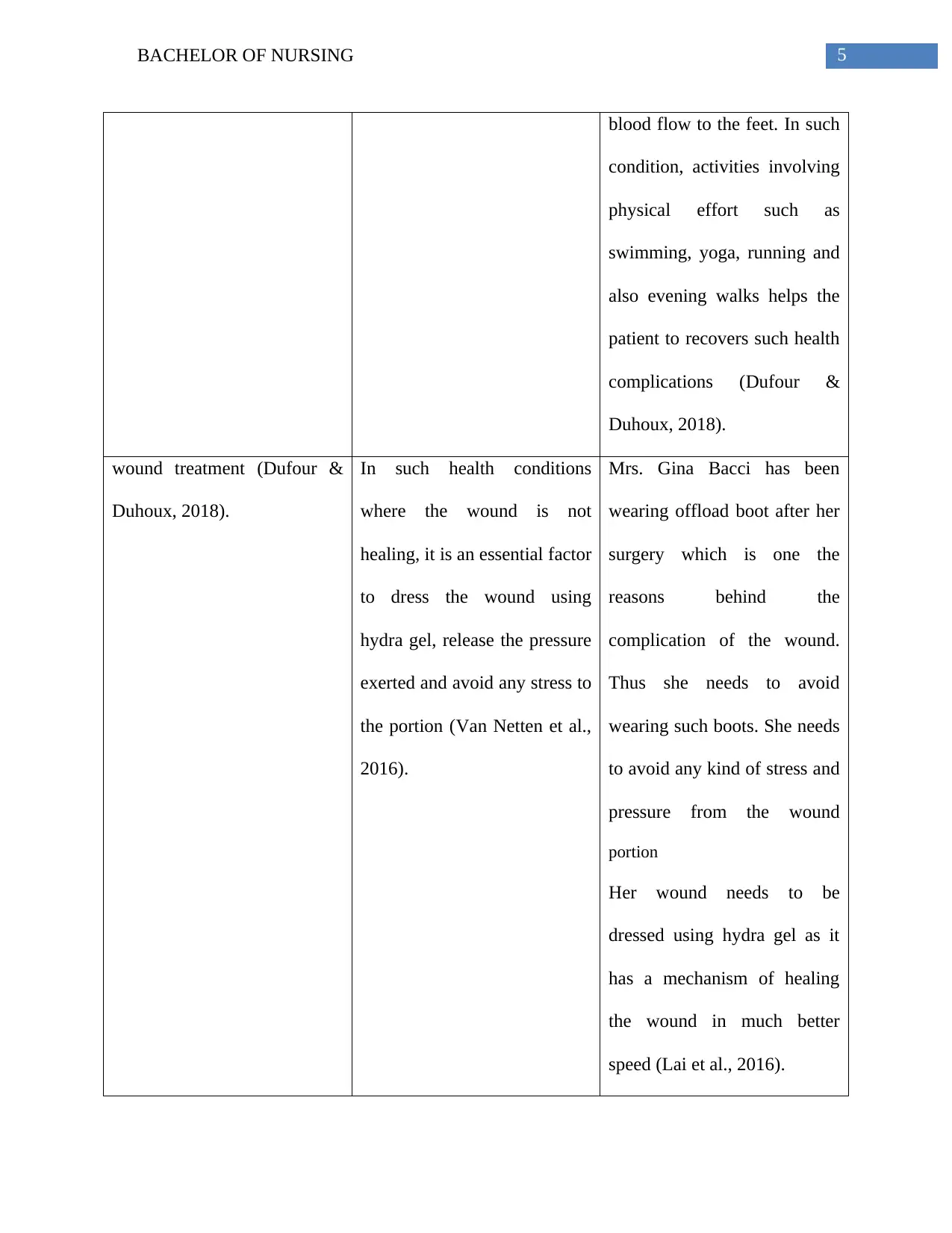
5BACHELOR OF NURSING
blood flow to the feet. In such
condition, activities involving
physical effort such as
swimming, yoga, running and
also evening walks helps the
patient to recovers such health
complications (Dufour &
Duhoux, 2018).
wound treatment (Dufour &
Duhoux, 2018).
In such health conditions
where the wound is not
healing, it is an essential factor
to dress the wound using
hydra gel, release the pressure
exerted and avoid any stress to
the portion (Van Netten et al.,
2016).
Mrs. Gina Bacci has been
wearing offload boot after her
surgery which is one the
reasons behind the
complication of the wound.
Thus she needs to avoid
wearing such boots. She needs
to avoid any kind of stress and
pressure from the wound
portion
Her wound needs to be
dressed using hydra gel as it
has a mechanism of healing
the wound in much better
speed (Lai et al., 2016).
blood flow to the feet. In such
condition, activities involving
physical effort such as
swimming, yoga, running and
also evening walks helps the
patient to recovers such health
complications (Dufour &
Duhoux, 2018).
wound treatment (Dufour &
Duhoux, 2018).
In such health conditions
where the wound is not
healing, it is an essential factor
to dress the wound using
hydra gel, release the pressure
exerted and avoid any stress to
the portion (Van Netten et al.,
2016).
Mrs. Gina Bacci has been
wearing offload boot after her
surgery which is one the
reasons behind the
complication of the wound.
Thus she needs to avoid
wearing such boots. She needs
to avoid any kind of stress and
pressure from the wound
portion
Her wound needs to be
dressed using hydra gel as it
has a mechanism of healing
the wound in much better
speed (Lai et al., 2016).
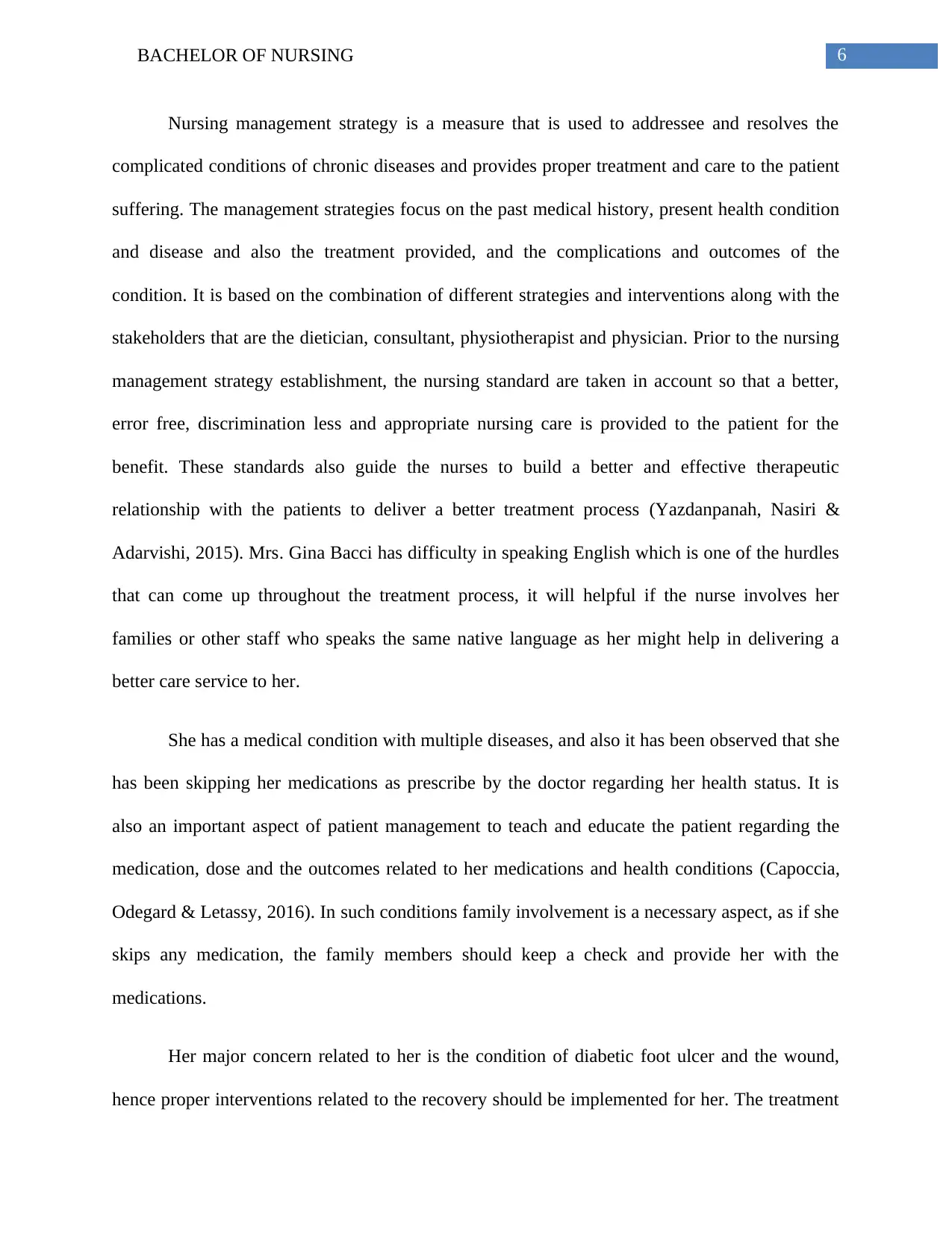
6BACHELOR OF NURSING
Nursing management strategy is a measure that is used to addressee and resolves the
complicated conditions of chronic diseases and provides proper treatment and care to the patient
suffering. The management strategies focus on the past medical history, present health condition
and disease and also the treatment provided, and the complications and outcomes of the
condition. It is based on the combination of different strategies and interventions along with the
stakeholders that are the dietician, consultant, physiotherapist and physician. Prior to the nursing
management strategy establishment, the nursing standard are taken in account so that a better,
error free, discrimination less and appropriate nursing care is provided to the patient for the
benefit. These standards also guide the nurses to build a better and effective therapeutic
relationship with the patients to deliver a better treatment process (Yazdanpanah, Nasiri &
Adarvishi, 2015). Mrs. Gina Bacci has difficulty in speaking English which is one of the hurdles
that can come up throughout the treatment process, it will helpful if the nurse involves her
families or other staff who speaks the same native language as her might help in delivering a
better care service to her.
She has a medical condition with multiple diseases, and also it has been observed that she
has been skipping her medications as prescribe by the doctor regarding her health status. It is
also an important aspect of patient management to teach and educate the patient regarding the
medication, dose and the outcomes related to her medications and health conditions (Capoccia,
Odegard & Letassy, 2016). In such conditions family involvement is a necessary aspect, as if she
skips any medication, the family members should keep a check and provide her with the
medications.
Her major concern related to her is the condition of diabetic foot ulcer and the wound,
hence proper interventions related to the recovery should be implemented for her. The treatment
Nursing management strategy is a measure that is used to addressee and resolves the
complicated conditions of chronic diseases and provides proper treatment and care to the patient
suffering. The management strategies focus on the past medical history, present health condition
and disease and also the treatment provided, and the complications and outcomes of the
condition. It is based on the combination of different strategies and interventions along with the
stakeholders that are the dietician, consultant, physiotherapist and physician. Prior to the nursing
management strategy establishment, the nursing standard are taken in account so that a better,
error free, discrimination less and appropriate nursing care is provided to the patient for the
benefit. These standards also guide the nurses to build a better and effective therapeutic
relationship with the patients to deliver a better treatment process (Yazdanpanah, Nasiri &
Adarvishi, 2015). Mrs. Gina Bacci has difficulty in speaking English which is one of the hurdles
that can come up throughout the treatment process, it will helpful if the nurse involves her
families or other staff who speaks the same native language as her might help in delivering a
better care service to her.
She has a medical condition with multiple diseases, and also it has been observed that she
has been skipping her medications as prescribe by the doctor regarding her health status. It is
also an important aspect of patient management to teach and educate the patient regarding the
medication, dose and the outcomes related to her medications and health conditions (Capoccia,
Odegard & Letassy, 2016). In such conditions family involvement is a necessary aspect, as if she
skips any medication, the family members should keep a check and provide her with the
medications.
Her major concern related to her is the condition of diabetic foot ulcer and the wound,
hence proper interventions related to the recovery should be implemented for her. The treatment
Paraphrase This Document
Need a fresh take? Get an instant paraphrase of this document with our AI Paraphraser
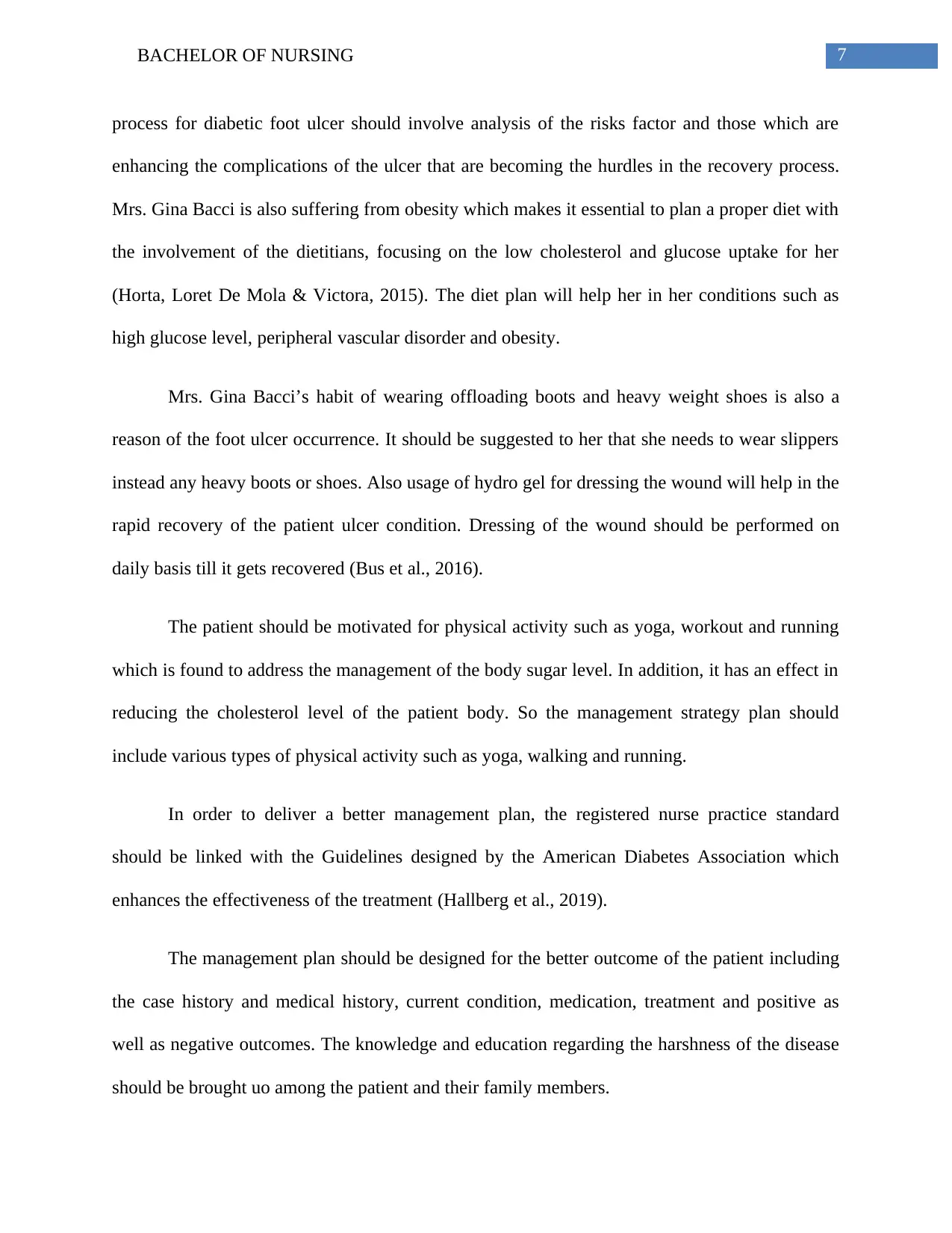
7BACHELOR OF NURSING
process for diabetic foot ulcer should involve analysis of the risks factor and those which are
enhancing the complications of the ulcer that are becoming the hurdles in the recovery process.
Mrs. Gina Bacci is also suffering from obesity which makes it essential to plan a proper diet with
the involvement of the dietitians, focusing on the low cholesterol and glucose uptake for her
(Horta, Loret De Mola & Victora, 2015). The diet plan will help her in her conditions such as
high glucose level, peripheral vascular disorder and obesity.
Mrs. Gina Bacci’s habit of wearing offloading boots and heavy weight shoes is also a
reason of the foot ulcer occurrence. It should be suggested to her that she needs to wear slippers
instead any heavy boots or shoes. Also usage of hydro gel for dressing the wound will help in the
rapid recovery of the patient ulcer condition. Dressing of the wound should be performed on
daily basis till it gets recovered (Bus et al., 2016).
The patient should be motivated for physical activity such as yoga, workout and running
which is found to address the management of the body sugar level. In addition, it has an effect in
reducing the cholesterol level of the patient body. So the management strategy plan should
include various types of physical activity such as yoga, walking and running.
In order to deliver a better management plan, the registered nurse practice standard
should be linked with the Guidelines designed by the American Diabetes Association which
enhances the effectiveness of the treatment (Hallberg et al., 2019).
The management plan should be designed for the better outcome of the patient including
the case history and medical history, current condition, medication, treatment and positive as
well as negative outcomes. The knowledge and education regarding the harshness of the disease
should be brought uo among the patient and their family members.
process for diabetic foot ulcer should involve analysis of the risks factor and those which are
enhancing the complications of the ulcer that are becoming the hurdles in the recovery process.
Mrs. Gina Bacci is also suffering from obesity which makes it essential to plan a proper diet with
the involvement of the dietitians, focusing on the low cholesterol and glucose uptake for her
(Horta, Loret De Mola & Victora, 2015). The diet plan will help her in her conditions such as
high glucose level, peripheral vascular disorder and obesity.
Mrs. Gina Bacci’s habit of wearing offloading boots and heavy weight shoes is also a
reason of the foot ulcer occurrence. It should be suggested to her that she needs to wear slippers
instead any heavy boots or shoes. Also usage of hydro gel for dressing the wound will help in the
rapid recovery of the patient ulcer condition. Dressing of the wound should be performed on
daily basis till it gets recovered (Bus et al., 2016).
The patient should be motivated for physical activity such as yoga, workout and running
which is found to address the management of the body sugar level. In addition, it has an effect in
reducing the cholesterol level of the patient body. So the management strategy plan should
include various types of physical activity such as yoga, walking and running.
In order to deliver a better management plan, the registered nurse practice standard
should be linked with the Guidelines designed by the American Diabetes Association which
enhances the effectiveness of the treatment (Hallberg et al., 2019).
The management plan should be designed for the better outcome of the patient including
the case history and medical history, current condition, medication, treatment and positive as
well as negative outcomes. The knowledge and education regarding the harshness of the disease
should be brought uo among the patient and their family members.
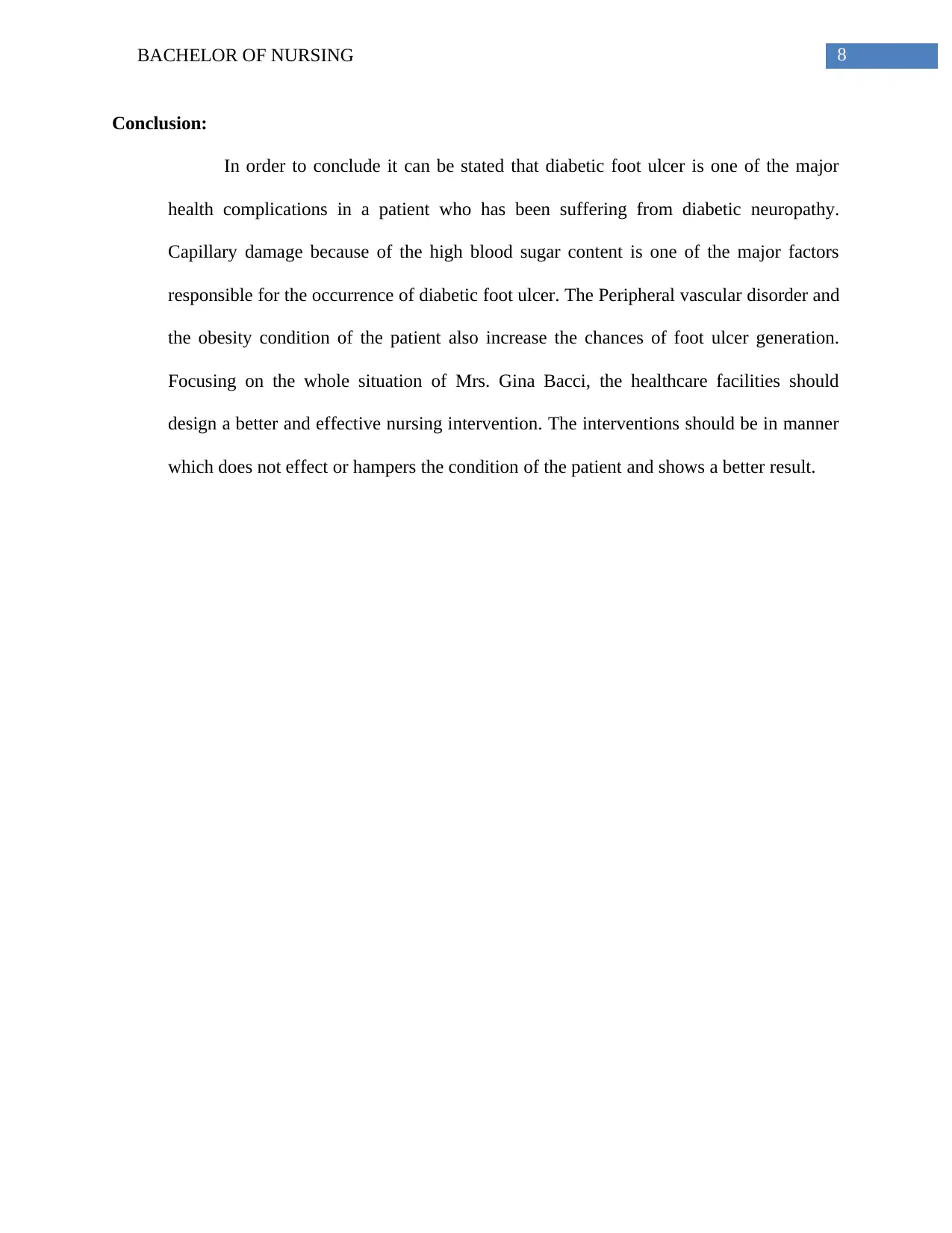
8BACHELOR OF NURSING
Conclusion:
In order to conclude it can be stated that diabetic foot ulcer is one of the major
health complications in a patient who has been suffering from diabetic neuropathy.
Capillary damage because of the high blood sugar content is one of the major factors
responsible for the occurrence of diabetic foot ulcer. The Peripheral vascular disorder and
the obesity condition of the patient also increase the chances of foot ulcer generation.
Focusing on the whole situation of Mrs. Gina Bacci, the healthcare facilities should
design a better and effective nursing intervention. The interventions should be in manner
which does not effect or hampers the condition of the patient and shows a better result.
Conclusion:
In order to conclude it can be stated that diabetic foot ulcer is one of the major
health complications in a patient who has been suffering from diabetic neuropathy.
Capillary damage because of the high blood sugar content is one of the major factors
responsible for the occurrence of diabetic foot ulcer. The Peripheral vascular disorder and
the obesity condition of the patient also increase the chances of foot ulcer generation.
Focusing on the whole situation of Mrs. Gina Bacci, the healthcare facilities should
design a better and effective nursing intervention. The interventions should be in manner
which does not effect or hampers the condition of the patient and shows a better result.
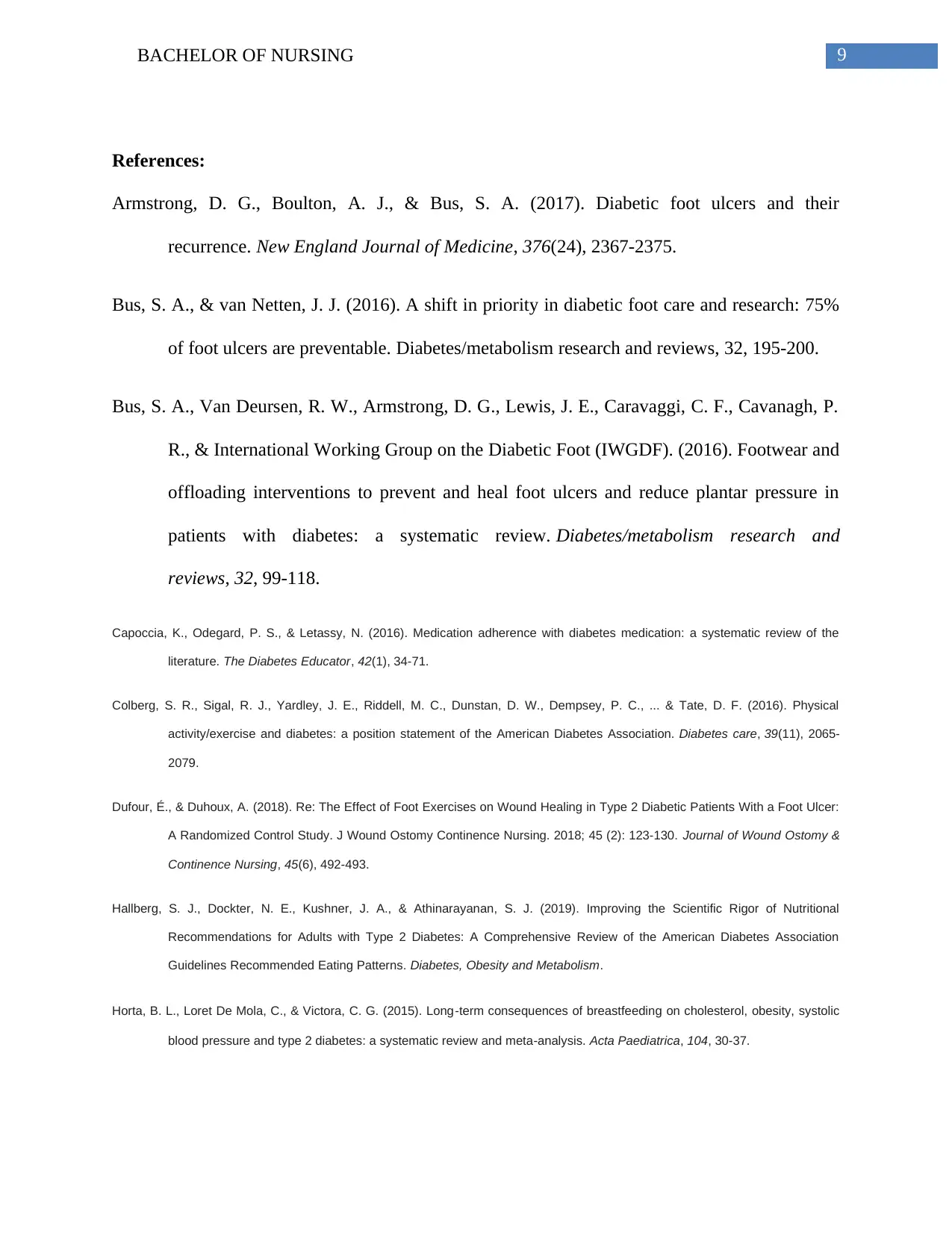
9BACHELOR OF NURSING
References:
Armstrong, D. G., Boulton, A. J., & Bus, S. A. (2017). Diabetic foot ulcers and their
recurrence. New England Journal of Medicine, 376(24), 2367-2375.
Bus, S. A., & van Netten, J. J. (2016). A shift in priority in diabetic foot care and research: 75%
of foot ulcers are preventable. Diabetes/metabolism research and reviews, 32, 195-200.
Bus, S. A., Van Deursen, R. W., Armstrong, D. G., Lewis, J. E., Caravaggi, C. F., Cavanagh, P.
R., & International Working Group on the Diabetic Foot (IWGDF). (2016). Footwear and
offloading interventions to prevent and heal foot ulcers and reduce plantar pressure in
patients with diabetes: a systematic review. Diabetes/metabolism research and
reviews, 32, 99-118.
Capoccia, K., Odegard, P. S., & Letassy, N. (2016). Medication adherence with diabetes medication: a systematic review of the
literature. The Diabetes Educator, 42(1), 34-71.
Colberg, S. R., Sigal, R. J., Yardley, J. E., Riddell, M. C., Dunstan, D. W., Dempsey, P. C., ... & Tate, D. F. (2016). Physical
activity/exercise and diabetes: a position statement of the American Diabetes Association. Diabetes care, 39(11), 2065-
2079.
Dufour, É., & Duhoux, A. (2018). Re: The Effect of Foot Exercises on Wound Healing in Type 2 Diabetic Patients With a Foot Ulcer:
A Randomized Control Study. J Wound Ostomy Continence Nursing. 2018; 45 (2): 123-130. Journal of Wound Ostomy &
Continence Nursing, 45(6), 492-493.
Hallberg, S. J., Dockter, N. E., Kushner, J. A., & Athinarayanan, S. J. (2019). Improving the Scientific Rigor of Nutritional
Recommendations for Adults with Type 2 Diabetes: A Comprehensive Review of the American Diabetes Association
Guidelines Recommended Eating Patterns. Diabetes, Obesity and Metabolism.
Horta, B. L., Loret De Mola, C., & Victora, C. G. (2015). Long‐term consequences of breastfeeding on cholesterol, obesity, systolic
blood pressure and type 2 diabetes: a systematic review and meta‐analysis. Acta Paediatrica, 104, 30-37.
References:
Armstrong, D. G., Boulton, A. J., & Bus, S. A. (2017). Diabetic foot ulcers and their
recurrence. New England Journal of Medicine, 376(24), 2367-2375.
Bus, S. A., & van Netten, J. J. (2016). A shift in priority in diabetic foot care and research: 75%
of foot ulcers are preventable. Diabetes/metabolism research and reviews, 32, 195-200.
Bus, S. A., Van Deursen, R. W., Armstrong, D. G., Lewis, J. E., Caravaggi, C. F., Cavanagh, P.
R., & International Working Group on the Diabetic Foot (IWGDF). (2016). Footwear and
offloading interventions to prevent and heal foot ulcers and reduce plantar pressure in
patients with diabetes: a systematic review. Diabetes/metabolism research and
reviews, 32, 99-118.
Capoccia, K., Odegard, P. S., & Letassy, N. (2016). Medication adherence with diabetes medication: a systematic review of the
literature. The Diabetes Educator, 42(1), 34-71.
Colberg, S. R., Sigal, R. J., Yardley, J. E., Riddell, M. C., Dunstan, D. W., Dempsey, P. C., ... & Tate, D. F. (2016). Physical
activity/exercise and diabetes: a position statement of the American Diabetes Association. Diabetes care, 39(11), 2065-
2079.
Dufour, É., & Duhoux, A. (2018). Re: The Effect of Foot Exercises on Wound Healing in Type 2 Diabetic Patients With a Foot Ulcer:
A Randomized Control Study. J Wound Ostomy Continence Nursing. 2018; 45 (2): 123-130. Journal of Wound Ostomy &
Continence Nursing, 45(6), 492-493.
Hallberg, S. J., Dockter, N. E., Kushner, J. A., & Athinarayanan, S. J. (2019). Improving the Scientific Rigor of Nutritional
Recommendations for Adults with Type 2 Diabetes: A Comprehensive Review of the American Diabetes Association
Guidelines Recommended Eating Patterns. Diabetes, Obesity and Metabolism.
Horta, B. L., Loret De Mola, C., & Victora, C. G. (2015). Long‐term consequences of breastfeeding on cholesterol, obesity, systolic
blood pressure and type 2 diabetes: a systematic review and meta‐analysis. Acta Paediatrica, 104, 30-37.
Secure Best Marks with AI Grader
Need help grading? Try our AI Grader for instant feedback on your assignments.
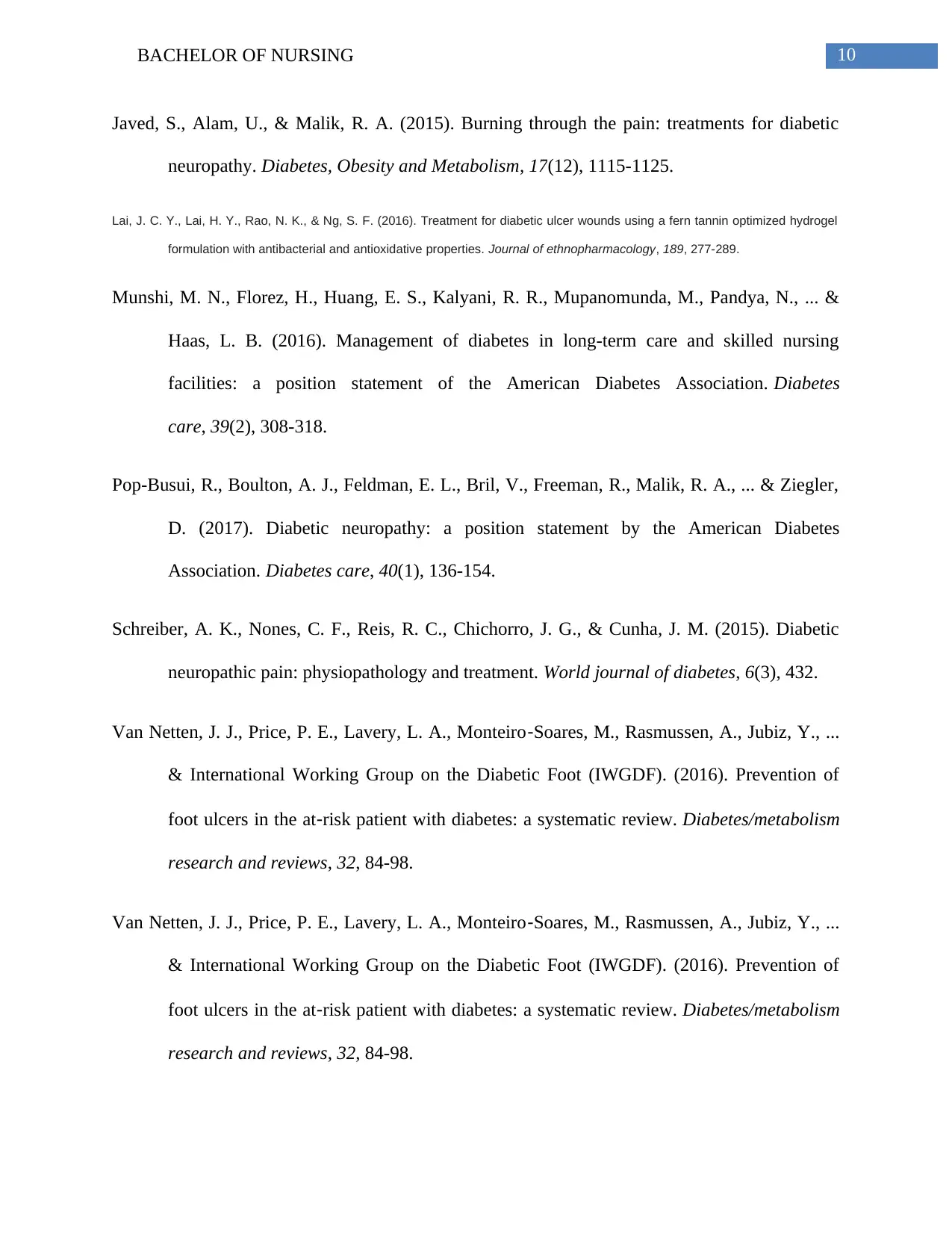
10BACHELOR OF NURSING
Javed, S., Alam, U., & Malik, R. A. (2015). Burning through the pain: treatments for diabetic
neuropathy. Diabetes, Obesity and Metabolism, 17(12), 1115-1125.
Lai, J. C. Y., Lai, H. Y., Rao, N. K., & Ng, S. F. (2016). Treatment for diabetic ulcer wounds using a fern tannin optimized hydrogel
formulation with antibacterial and antioxidative properties. Journal of ethnopharmacology, 189, 277-289.
Munshi, M. N., Florez, H., Huang, E. S., Kalyani, R. R., Mupanomunda, M., Pandya, N., ... &
Haas, L. B. (2016). Management of diabetes in long-term care and skilled nursing
facilities: a position statement of the American Diabetes Association. Diabetes
care, 39(2), 308-318.
Pop-Busui, R., Boulton, A. J., Feldman, E. L., Bril, V., Freeman, R., Malik, R. A., ... & Ziegler,
D. (2017). Diabetic neuropathy: a position statement by the American Diabetes
Association. Diabetes care, 40(1), 136-154.
Schreiber, A. K., Nones, C. F., Reis, R. C., Chichorro, J. G., & Cunha, J. M. (2015). Diabetic
neuropathic pain: physiopathology and treatment. World journal of diabetes, 6(3), 432.
Van Netten, J. J., Price, P. E., Lavery, L. A., Monteiro‐Soares, M., Rasmussen, A., Jubiz, Y., ...
& International Working Group on the Diabetic Foot (IWGDF). (2016). Prevention of
foot ulcers in the at‐risk patient with diabetes: a systematic review. Diabetes/metabolism
research and reviews, 32, 84-98.
Van Netten, J. J., Price, P. E., Lavery, L. A., Monteiro‐Soares, M., Rasmussen, A., Jubiz, Y., ...
& International Working Group on the Diabetic Foot (IWGDF). (2016). Prevention of
foot ulcers in the at‐risk patient with diabetes: a systematic review. Diabetes/metabolism
research and reviews, 32, 84-98.
Javed, S., Alam, U., & Malik, R. A. (2015). Burning through the pain: treatments for diabetic
neuropathy. Diabetes, Obesity and Metabolism, 17(12), 1115-1125.
Lai, J. C. Y., Lai, H. Y., Rao, N. K., & Ng, S. F. (2016). Treatment for diabetic ulcer wounds using a fern tannin optimized hydrogel
formulation with antibacterial and antioxidative properties. Journal of ethnopharmacology, 189, 277-289.
Munshi, M. N., Florez, H., Huang, E. S., Kalyani, R. R., Mupanomunda, M., Pandya, N., ... &
Haas, L. B. (2016). Management of diabetes in long-term care and skilled nursing
facilities: a position statement of the American Diabetes Association. Diabetes
care, 39(2), 308-318.
Pop-Busui, R., Boulton, A. J., Feldman, E. L., Bril, V., Freeman, R., Malik, R. A., ... & Ziegler,
D. (2017). Diabetic neuropathy: a position statement by the American Diabetes
Association. Diabetes care, 40(1), 136-154.
Schreiber, A. K., Nones, C. F., Reis, R. C., Chichorro, J. G., & Cunha, J. M. (2015). Diabetic
neuropathic pain: physiopathology and treatment. World journal of diabetes, 6(3), 432.
Van Netten, J. J., Price, P. E., Lavery, L. A., Monteiro‐Soares, M., Rasmussen, A., Jubiz, Y., ...
& International Working Group on the Diabetic Foot (IWGDF). (2016). Prevention of
foot ulcers in the at‐risk patient with diabetes: a systematic review. Diabetes/metabolism
research and reviews, 32, 84-98.
Van Netten, J. J., Price, P. E., Lavery, L. A., Monteiro‐Soares, M., Rasmussen, A., Jubiz, Y., ...
& International Working Group on the Diabetic Foot (IWGDF). (2016). Prevention of
foot ulcers in the at‐risk patient with diabetes: a systematic review. Diabetes/metabolism
research and reviews, 32, 84-98.
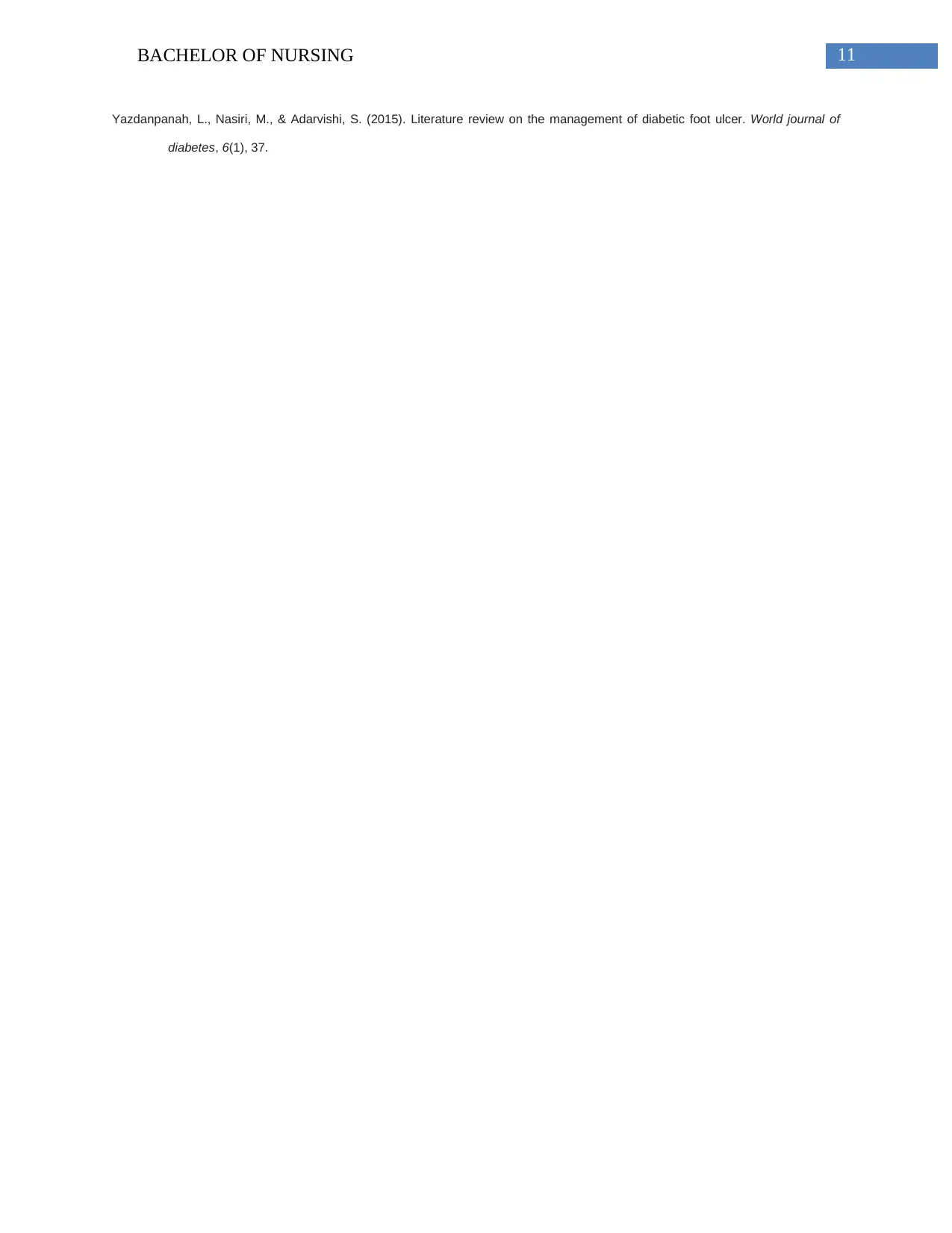
11BACHELOR OF NURSING
Yazdanpanah, L., Nasiri, M., & Adarvishi, S. (2015). Literature review on the management of diabetic foot ulcer. World journal of
diabetes, 6(1), 37.
Yazdanpanah, L., Nasiri, M., & Adarvishi, S. (2015). Literature review on the management of diabetic foot ulcer. World journal of
diabetes, 6(1), 37.
1 out of 12
Related Documents
Your All-in-One AI-Powered Toolkit for Academic Success.
+13062052269
info@desklib.com
Available 24*7 on WhatsApp / Email
![[object Object]](/_next/static/media/star-bottom.7253800d.svg)
Unlock your academic potential
© 2024 | Zucol Services PVT LTD | All rights reserved.




